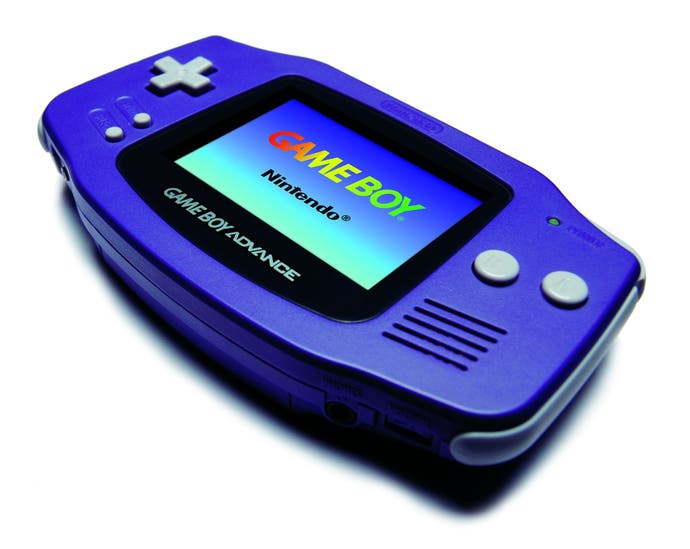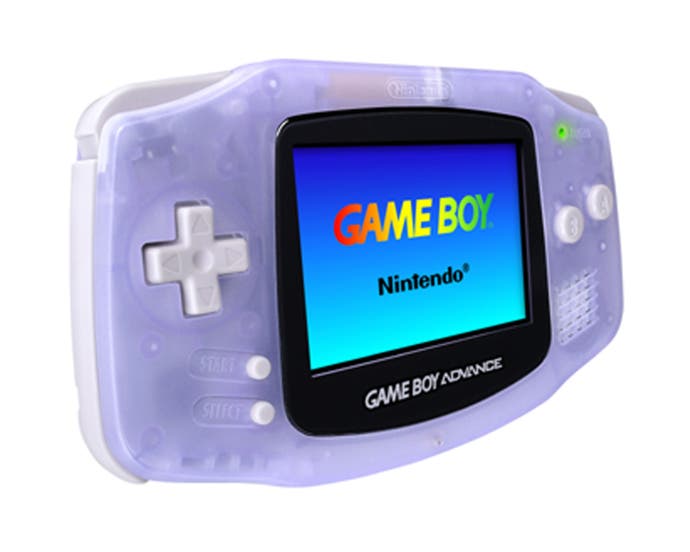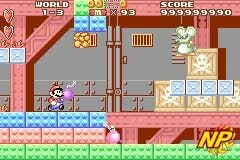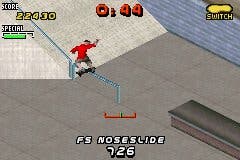The Portable Avant-Garde
Article - congratulations Nintendo, it's a 'Boy

The True Next Generation
People associate the idea of gaming on the go with Nintendo, and with over 100 million GameBoys sold since the console's inception, that's hardly surprising. There have been pretenders, like Sega's Game Gear and more recently the Neo Geo Pocket Color, but nothing has ever really rivalled Mario and co. on the go. Nintendo's latest revision of the GameBoy formula is called "GameBoy Advance", and it ups the ante by quite some way, changing cartridge size for the first time in history and beefing up performance to overcome 16-bit consoles like the Super Nintendo and even bump the underside of more recent units like the PlayStation. Indeed, much of the GBA's gaming catalogue is occupied by former SNES properties, like Mario Kart, and PlayStation hits like Castlevania. From a marketing perspective, the only strategy involved is how best to roll out the many hundreds of games in development. Due out on the 22nd of June, sales won't be as impressive as they would be in the run up to Christmas, but with so many different communities of fans clawing for a unit, the launch will be difficult to screw up. The sorts of people that will buy GameBoy Advance come from many different backgrounds. Some will be former GameBoy and GameBoy Color owners, eager to find out what all the hype has been about, whilst others will be veterans of the 16-bit era, drooling over SNES revamps like Tactics Ogre Gaiden and positively fawning over the likes of F-Zero Advance. The rest will be swept along by the hype and excitement surrounding this new format. For us, there's no alternative for those haul flights to exotic press events. [Yes, shame you never get to go to those, my young apprentice - Dark Ed] Some feel that the GameBoy Advance signals the re-birth of the handheld games industry. "The handheld market is likely to pull in players that may not have bothered with games before," Asam Ahmad, Senior PR Manager at THQ told us. "This can only be good for the industry as a whole as gaming becomes more integrated into social activity and hence broadens the market."

The Science Bit
When Nintendo first introduced colour to the GameBoy line, it was thought to be quite a progression. In reality though, distinguishing the difference between monochrome and colour games was difficult in all but the best lighting conditions. Compared to the Colour unit though, the GameBoy Advance can handle more than twice the number of colours and almost 10 times as many simultaneously. That's before you take its higher native resolution (240x160 compared to 160x140) into account, and its larger, widescreen 2.9" TFT reflective display. What's more impressive though is that for the same batteries it can handle 15 hours, compared with the 10 hours of activity the GameBoy Color will give you before dropping off for a nap. Nintendo have cut very few corners in the GameBoy Advance design, with a 32-bit ARM processor using embedded memory at the centre of things. If you think that makes the GBC sound like a Z80, that's hardly surprising. It is an 8-bit Z80. It's not just the raw specifications that have impressed the press and consumers alike though. There are more buttons, smaller cartridge sizes and a better link cable system allowing for up to four players (it's even been paraded around that some games will do up to four player multiplayer with only one cartridge). The two extra buttons are SNES-like shoulder buttons, made famous by the heavy kicks and punches in Street Fighter and the little powerslide hop in Mario Kart, and it's no coincidence they're here either. Many consider the GBA to be equivalent to a portable Super Nintendo. Indeed, many are choosing to buy it purely on that basis.
The Science Bit, continued
But how close is it to a Super Nintendo? Well lets compare. The Super Nintendo was driven by an Atari made 65c816 16-bit processor. This was kicking about in Apple IIes as well judging from the technical documentation available on the web, and could change between 2.68 and 3.58 MHz operational speeds. By comparison, the 32-bit ARM processor is a very different technology, but anything the Super Nintendo could do, it could do in its sleep. In fact, out and out comparison is difficult to do without sounding like some sort of complete geek, and no doubt confusing everybody who's been reading up to this point. It would be fair to say though that the GBA's processor is capable of emulating the work of the 65c816 accurately where needed. In fact it would be fair to say that it kicks the 65c816 around the shop whenever it draws breath. Next up is the video output. The native resolution is obviously different since the SNES ran on televisions. According to documentation readily available on the Internet, SNES output was 512x448, compared to the widescreen 240x160 of the GBA. On the palette side of things, the GBA can do twice as many colours as the SNES' 32,768, and twice as many again simultaneously as the SNES' 256. Ignoring sound facilities and varying cartridge sizes (memory wise rather than physically!), the GBA can pin the SNES to the ground and still have a hand free to wave to the ladies. On the other end of the scale though, systems like the PlayStation and Saturn give it a moderate whipping. This is perhaps why a lot of SNES games have seen (or will see) conversion, while higher end titles have been resigned to license fodder. The ideal example here being Tony Hawk's Pro Skater 2, which may well be good, but will never look the same way on the GBA's hardware. Apart from its portability, SNES-beating power and enormous games catalogue though, the most impressive feature is the console's backwards compatibility with former GameBoy/Color games. Anything from either console is supposed to work, and fits in a small 160x140 resolution box in the centre of the wide GBA screen. During our time with the console we've tested everything from a proper, original monochrome copy of Tetris to recent colour titles like Metal Gear Solid. All work. Nintendo are even saying that owners of the GBA will be able to use it as a controller for the GameCube if they so wish. For its rivals, the GameBoy Advance must be a shocking opponent. The only way it's likely to be overcome is by mobile phone integration, and that seems to be fatally flawed for the simple reason that people prefer dedicated devices, and hell, like to play games while chatting to people on the phone just as much as without. Anyway, I digress…
Games
Although a lot of consumers don't know this, Super Mario Advance, arguably the flagship Nintendo release for historical reasons, actually started life as a little known platformer called Doki Doki Panic in Japan. Renamed to Super Mario Brothers 2 for the USA and with its various character sprites and story panels redeveloped, it never lived up to the original Mario Brothers' success, and many attributed that to a distinctive change in style. Although a perfectly enjoyable game in its own right, in the opinion of press and public the game that should have front-lined the GBA line-up was its Nintendo-developed sequel, the seminal Super Mario Brothers 3. In Japan, the real Super Mario Brothers 2 was subtitled "The Lost Levels", and was in essence an extremely difficult extension of the original Mario game. Compared to The Lost Levels, Doki Doki Panic was extremely popular in Japan, and Nintendo believed that by switching the graphics about a bit and altering the simple storyline they could easily market it as a sequel to the original Western-released Mario Bros. Game. It's slightly more difficult to trace Nintendo's decision to use SMB2 on the GameBoy Advance though. Nobody representing the company was prepared for us to take them that far back in history and shrugged off our questions pretty swiftly. It'll be interesting to see what the public make of Mario Advance. A number of people were also surprised by Nintendo's decision to hold off Mario Kart Advance, too. Hardened cynic that I am, I reckon this is in part related to Mario Advance's less than favourable origins. Allow me to explain. You may have spotted that it's not Christmas. For Nintendo, launching a console in the middle of nowhere is a bit of a gamble, but if they hold back a couple of killer GBA titles, they can score big points in the run up to the festive season with a hardware price cut and a couple of high profile releases. So come Christmas, we expect to see bundles including Mario Kart Advance (a sure-fire hit whichever way you look at it), and perhaps an as-yet undisclosed Mario title based on Super Mario Brothers 3. Let's face it, Nintendo would be mad not to release an SMB3 conversion somewhere down the line. Perhaps that should be madder, but you get my point. Completing the Nintendo line-up for the June 22nd launch though are two tremendously exciting titles. F-Zero Advance, which builds on the SNES' first real killer app of the early 90s, and Kuru Kuru Kururin, a genuinely original puzzle game that looks set to cause quite a stir for commuters. F-Zero Advance, of course, started life as an exhibition of Mode 7 racing, and buried the competing Sega Mega Drive in festive sales. It's still distinctly playable, and we fancy its release on the GameBoy Advance will be one of the most popular.

Games, continued
Kuru Kuru on the other hand, as we explained at last year's ECTS, is a puzzle game with a twist. Literally. You control a little magic wand stick thing, which spins perpetually. Your job, judging the turn of the stick, is to manoeuvre it through an obstacle course of twists and turns without once allowing it to make contact with the side. It was manic fun a year ago, but we don't think the intervening period will have had any negative effect. One to watch out for. Elsewhere on the console, Konami are making a big launch push with Castlevania, Krazy Racers and later on, Silent Hill. A lot of former Super Nintendo addicts have already pledged their allegiance to Castlevania for historical reasons, while others are anxious to see how Silent Hill turns out. Survival horror on a portable should, after all, be something of a fine art to perfect. We're betting Krazy Racers will fill the void left by Mario Kart Advance at launch. Judging from our experience with it at ECTS, it's a very similar game to the original Super Nintendo Mario Kart, and will take up its duties as time thief with the real McCoy still several months off. Our picks of the rest are Sega's twins, Chu Chu Rocket and Sonic The Hedgehog, Ubi-Soft's Rayman Advance and Tony Hawk's Pro Skater 2 from Activision. Chu Chu will be nigh on identical to its Dreamcast relative, while Sonic The Hedgehog will draw on Mega Drive successes Sonic 1 & 2. As we wrote at E3, Rayman Advance will be a hallmark platform title amongst the early GBA releases, with proper platform roots and a simple good versus evil storyline involving the nefarious Mr. Dark. Tony Hawk's is the dark horse of the lot. In light of Neversoft's work on the full-time consoles, it's built on an absolutely monstrous license, but because of platform limitations will have to make do with a third person isometric angle. We trust in Neversoft, but who knows? We'll have to wait and see. Coming up before the end of the year are even more high profile releases from Nintendo, Activision and also THQ. Activision's work will focus on license-bait like Spider-Man and the X-Men, both games we're anxious to get our hands on, while THQ have cornered virtually every genre on the map in some way or another. "Given our strong prominence in the handheld market, we are aggressively pursuing further big name brands to bring to Nintendo's new portable," Asam told us. "We have announced over 15 titles so far for 2001."

Word on the street
The only part of the GameBoy Advance equation that has met with criticism is its price point. As Gameplay.co.uk Internet Channel Manager Mat Braddy told us, "Nintendo have not set a RRP for the GBA because this is no longer allowed," but even so the street price of £85 might seem quite high. Mat doesn't think so though. "This seems very high for a system targeted mainly at 14 year olds, however you have to remember that the original Game Boy is still on sale in most places for around £60-£70. It's ten years old and the most installed console ever made. Is £15 more really a lot to ask for the new 32 bit system? Not really." The big issue for Nintendo and retailers in pricing the console was supply versus demand. Nintendo cannot supply anywhere near enough units at this rate, so goodness only knows how they'd get on at a lower price. "We had pre-sold our allocated stock over a month ago and even though we have put up a note warning customers of delivery delays on new orders, it is still our number one selling item - out selling all games! Demand is huge." Incredibly, there seems to be a reasonable amount of sympathy for the pricing amongst consumers. One buyer we spoke to in particular seemed fairly indifferent. "I think it's fair enough given that the Colour Gameboy isn't that old, and is still going strong. I'd rather companies brought out new gear frequently but at a premium than have to wait, so I'm happy to pay the extra to be an early adopter and keep the CGB affordable for the kids," he told us. The interesting thing seems to be the small amount of games people are pre-ordering along with their consoles. "We think its due mainly to the fact its backward compatible," Mat Braddy told us. We're not so sure. With games going for £30 with an RRP of around £33, they cost as much if not more than leading PC titles, and with so many top launch titles there are hard choices to be made. Do you really want to spend over £150 for a GameBoy Advance and a couple of games? This must be fairly distressing for retailers, given the small margin they will make on the console versus that of the software. "We are selling the base unit for £82.99 however when you take into account postage etc we will not make a bean. On the High Street you can see retailers trying to work around this problem by only selling the console as part of higher priced bundles." According to Mat, the most popular pre-order has been Tony Hawk's Pro Skater 2, followed by F-Zero and Super Mario Advance. Sonic The Hedgehog and Konami Krazy Racers make up the rest of the top five while Mario Kart and even DOOM appear elsewhere in the top ten. However, Mat reckons that that might have something to do with his persuasive page layout at Gameplay.co.uk. [Did that sentence save you buying him a pint? - Ed]

Conclusions
There are a lot of hopes riding on the GameBoy Advance, and from our experiences with the console so far, not too much to worry about. Thanks to backwards compatibility and the console's ability to render Super Nintendo classics without breaking into a sweat, we imagine there will be a lot of satisfied customers at the end of the day, too. In terms of problems, we can think of only three, one of which is a proper problem, one a subjective little niggle and one a potential issue that may never arise. The main problem is the issue of supply. Like Sony, Nintendo have one hell of a lot of customers to deliver to, and not doing so could be damaging for the company. With the GameCube to occupy their supply lines at Christmas, shipping in limited quantities now and in large ones later won't really work either. In reality, Nintendo need to literally start churning out tonnes of GameBoy Advances and shipping to overburden the market with boxes. Then at Christmas the price will drop to shift units, people will buy them in their droves and the company will easily manage to fill in the gaps. Forget Tellytubby toys and Buzz Lightyear dolls, Christmas 2001 will be the year of the GameBoy Advance. Whatever Nintendo opt to do, we'll be there to cover it. Our subjective little niggle is the size of the GBA unit and positioning of the shoulder buttons. Fair enough, they do need to be shoulder buttons, as mashing four buttons on the right side of the console would be a bit much, but either our hands are too big or the console is too small, and it makes those shoulders a bit uncomfortable to reach for regularly. Once the machine is out in the open we'll ask a few of our friends what they reckon. As for the potential issue that will never arise, what happens if some GameBoy/Color games don't work on the supposedly backward compatible console. It would only take one or two notable failures for people to plaster Nintendo with disdainful comments the likes of which Sony saw a year ago when it let slip that "not everything" worked as it should. Apart from that, embarrassingly, we can't come up with anything. There is no competition, every publisher on the planet is adopting the format save Microsoft and Sony, and Nintendo are quoting 160 titles before the end of the year. Here's to 100 million GameBoy Advances in the next decade.













.jpg?width=291&height=164&fit=crop&quality=80&format=jpg&auto=webp)